Deciphering maternal-fetal cross-talk in the human placenta during parturition using single-cell RNA sequencing
- PMID: 38198568
- PMCID: PMC11238316
- DOI: 10.1126/scitranslmed.adh8335
Deciphering maternal-fetal cross-talk in the human placenta during parturition using single-cell RNA sequencing
Abstract
Labor is a complex physiological process requiring a well-orchestrated dialogue between the mother and fetus. However, the cellular contributions and communications that facilitate maternal-fetal cross-talk in labor have not been fully elucidated. Here, single-cell RNA sequencing (scRNA-seq) was applied to decipher maternal-fetal signaling in the human placenta during term labor. First, a single-cell atlas of the human placenta was established, demonstrating that maternal and fetal cell types underwent changes in transcriptomic activity during labor. Cell types most affected by labor were fetal stromal and maternal decidual cells in the chorioamniotic membranes (CAMs) and maternal and fetal myeloid cells in the placenta. Cell-cell interaction analyses showed that CAM and placental cell types participated in labor-driven maternal and fetal signaling, including the collagen, C-X-C motif ligand (CXCL), tumor necrosis factor (TNF), galectin, and interleukin-6 (IL-6) pathways. Integration of scRNA-seq data with publicly available bulk transcriptomic data showed that placenta-derived scRNA-seq signatures could be monitored in the maternal circulation throughout gestation and in labor. Moreover, comparative analysis revealed that placenta-derived signatures in term labor were mirrored by those in spontaneous preterm labor and birth. Furthermore, we demonstrated that early in gestation, labor-specific, placenta-derived signatures could be detected in the circulation of women destined to undergo spontaneous preterm birth, with either intact or prelabor ruptured membranes. Collectively, our findings provide insight into the maternal-fetal cross-talk of human parturition and suggest that placenta-derived single-cell signatures can aid in the development of noninvasive biomarkers for the prediction of preterm birth.
Conflict of interest statement
Competing interests:
The authors declare that they have no competing interests.
Figures
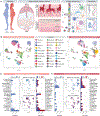

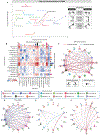
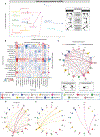
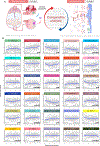
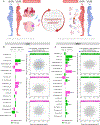

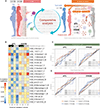
Similar articles
-
The landscape of decidual immune cells at the maternal-fetal interface in parturition and preterm birth.Inflamm Res. 2025 Mar 4;74(1):44. doi: 10.1007/s00011-025-02015-6. Inflamm Res. 2025. PMID: 40038160 Free PMC article. Review.
-
Single cell transcriptional signatures of the human placenta in term and preterm parturition.Elife. 2019 Dec 12;8:e52004. doi: 10.7554/eLife.52004. Elife. 2019. PMID: 31829938 Free PMC article.
-
The increased cfRNA of TNFSF4 in peripheral blood at late gestation and preterm labor: its implication as a noninvasive biomarker for premature delivery.Front Immunol. 2023 May 18;14:1154025. doi: 10.3389/fimmu.2023.1154025. eCollection 2023. Front Immunol. 2023. PMID: 37275889 Free PMC article.
-
Transcriptome changes in maternal peripheral blood during term parturition mimic perturbations preceding spontaneous preterm birth†.Biol Reprod. 2022 Jan 13;106(1):185-199. doi: 10.1093/biolre/ioab197. Biol Reprod. 2022. PMID: 34686873 Free PMC article.
-
Single-Cell Immunobiology of the Maternal-Fetal Interface.J Immunol. 2022 Oct 15;209(8):1450-1464. doi: 10.4049/jimmunol.2200433. J Immunol. 2022. PMID: 36192116 Free PMC article. Review.
Cited by
-
Homeostatic Macrophages Prevent Preterm Birth and Improve Neonatal Outcomes by Mitigating In Utero Sterile Inflammation in Mice.J Immunol. 2024 Dec 1;213(11):1620-1634. doi: 10.4049/jimmunol.2400467. J Immunol. 2024. PMID: 39431882 Free PMC article.
-
Differences in endocrine and reproductive responses to substance exposure across generations: highlighting the importance of complementary findings.Arch Toxicol. 2024 Oct;98(10):3215-3230. doi: 10.1007/s00204-024-03813-3. Epub 2024 Jul 18. Arch Toxicol. 2024. PMID: 39023799 Free PMC article.
-
The landscape of decidual immune cells at the maternal-fetal interface in parturition and preterm birth.Inflamm Res. 2025 Mar 4;74(1):44. doi: 10.1007/s00011-025-02015-6. Inflamm Res. 2025. PMID: 40038160 Free PMC article. Review.
-
Immunophenotyping and Activation Status of Maternal Lymphocytes to Predict Spontaneous Preterm Birth in Women With Threatened Preterm Labor: A Prospective Observational Study.Am J Reprod Immunol. 2024 Dec;92(6):e70015. doi: 10.1111/aji.70015. Am J Reprod Immunol. 2024. PMID: 39625044 Free PMC article.
-
Maternal and placental galectins: key players in the feto-maternal symbiotic tango.Semin Immunopathol. 2025 Aug 21;47(1):35. doi: 10.1007/s00281-025-01061-w. Semin Immunopathol. 2025. PMID: 40839117 Free PMC article. Review.
References
-
- Norwitz ER, Robinson JN, Challis JR, The control of labor. N Engl J Med 341, 660–666 (1999). - PubMed
-
- Challis JR, Bloomfield FH, Bocking AD, Casciani V, Chisaka H, Connor K, Dong X, Gluckman P, Harding JE, Johnstone J, Li W, Lye S, Okamura K, Premyslova M, Fetal signals and parturition. J Obstet Gynaecol Res 31, 492–499 (2005). - PubMed
-
- Romero R, Mazor M, Munoz H, Gomez R, Galasso M, Sherer DM, The preterm labor syndrome. Ann N Y Acad Sci 734, 414–429 (1994). - PubMed
-
- Smith R, Parturition. N Engl J Med 356, 271–283 (2007). - PubMed
Publication types
MeSH terms
Grants and funding
LinkOut - more resources
Full Text Sources
Molecular Biology Databases

